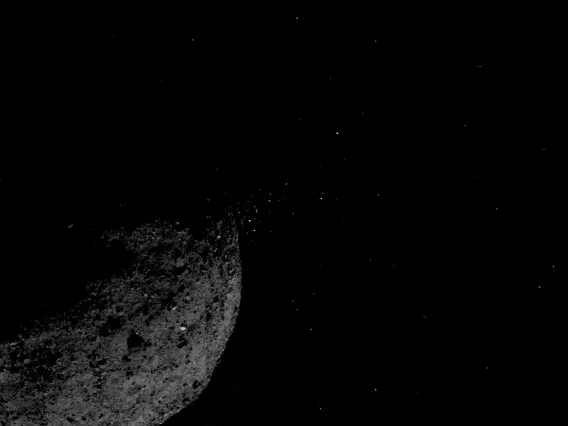
Where Rocks Come Alive: OSIRIS-REx Observes an Asteroid in Action
While studying asteroid Bennu up close, NASA's OSIRIS-REx spacecraft witnessed periodic outbursts of material being kicked up from the surface. A dedicated observation campaign revealed details of the activity and the processes likely causing it.
Where Rocks Come Alive: OSIRIS-REx Observes an Asteroid in Action
×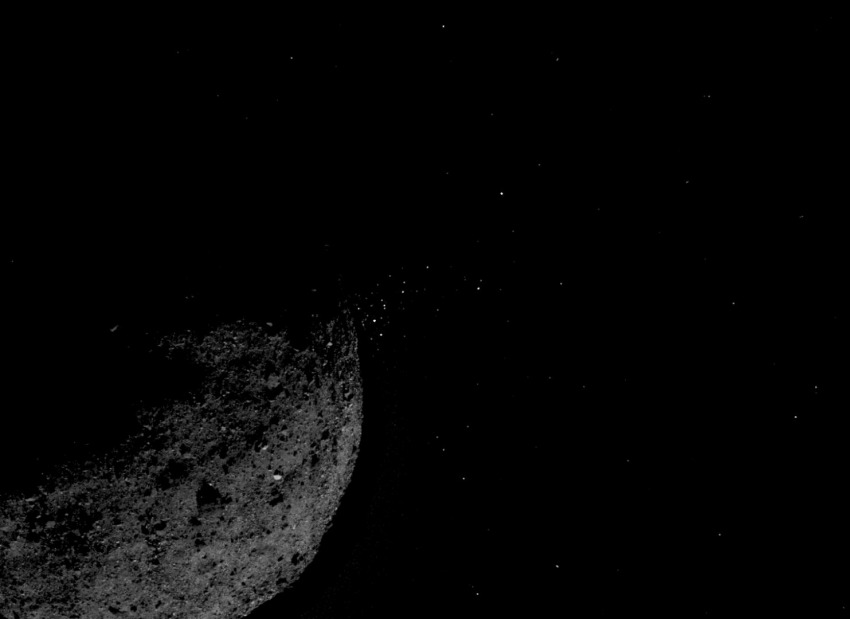
By Daniel Stolte, University Communications - September 9, 2020
It's 5 o'clock somewhere. And while here on Earth, "happy hour" is commonly associated with winding down and the optional cold beverage, that's when things get going on Bennu, the destination asteroid of the University of Arizona-led OSIRIS-REx NASA mission.
In a special collection of research papers published today in the Journal of Geophysical Research: Planets, the OSIRIS-REx science team reports detailed observations that reveal Bennu is shedding material on a regular basis, most often during Bennu's local two-hour afternoon and evening timeframe.
The OSIRIS-REx spacecraft has provided planetary scientists with the opportunity to observe such activity at close range for the first time ever, and Bennu's active surface underscores an emerging picture in which asteroids are quite dynamic worlds. The fleeing particles are the beginning of many revelations – from its gravitational field to its interior composition, Bennu's charisma continues to unfold for the team.
The publications provide the first in-depth look at the nature of Bennu's particle ejection events, detail the methods used to study these phenomena, and discuss the likely mechanisms that cause the asteroid to release pieces of itself into space.
The OSIRIS-REx spacecraft will grab a sample from the surface of Bennu in October and return it to Earth on Sept. 24, 2023. The first observation of particles popping off the asteroid's surface was made in January 2019, mere days after the spacecraft arrived at Bennu. This event may have gone completely unnoticed were it not for the keen eye of the mission's lead astronomer Carl Hergenrother, a scientist in the UArizona Lunar and Planetary Laboratory and one of the lead authors of the collection and its introductory paper.
Much like ocean-going explorers in centuries past, the OSIRIS-REx space probe relies on stars to fix its position in space and remain on course during its years-long voyage. A specialized navigation camera onboard the spacecraft takes repeat images of background stars. By cross-referencing the constellations the spacecraft "sees" with programmed star charts, and course corrections can be made as necessary.
Hergenrother was poring over these images that the spacecraft had beamed back to Earth when something caught his attention. The images showed the asteroid silhouetted against a black sky, dotted with many stars – except there seemed to be too many.
"I was looking at the star patterns in these images and thought, 'huh, I don't remember that star cluster,'" Hergenrother said. "I only noticed it because there were 200 dots of light where there should be about 10 stars. Other than that, it looked to be just a dense part of the sky."
A closer inspection and an application of image-processing techniques solved the mystery: The "star cluster" was, in fact, a cloud of tiny particles that had been ejected from the asteroid's surface. Follow-up observations made by the spacecraft revealed the telltale streaks typical of objects moving across the frame, setting them apart from the background stars that appear stationary due to their enormous distances.
"We thought that Bennu's boulder-covered surface was the wildcard discovery at the asteroid, but these particle events definitely surprised us," said Dante Lauretta, OSIRIS-REx principal investigator and professor in the UArizona Lunar and Planetary Laboratory. "We've spent the last year investigating Bennu's active surface, and it's provided us with a remarkable opportunity to expand our knowledge of how active asteroids behave."
Since arriving at the asteroid, the team has observed and tracked more than 300 particle ejection events on Bennu. According to the authors, some particles escape into space, others briefly orbit the asteroid, and most fall back onto its surface after being launched.
The spacecraft is equipped with a sophisticated set of electronic eyes – the Touch-and-Go Camera Suite, or TAGCAMS. Although its primary purpose is to assist in spacecraft navigation, TAGCAMS has now been placed into active duty spotting any particles in the vicinity of the asteroid.
Using software algorithms developed at UArizona's Catalina Sky Survey, which specializes in discovering and tracking near-Earth asteroids by detecting their motion against background stars, the OSIRIS-REx team found the largest particles erupting from Bennu to be about 6 centimeters (2 inches) in diameter. Due to their small size and low velocities – like a shower of tiny pebbles in super slow motion – the mission team does not deem the particles a threat to the spacecraft.
"Space is so empty that even when the asteroid is throwing off hundreds of particles, as we have seen in some events, the chances of one of those hitting the spacecraft is extremely small, and even if that were to happen, the vast majority of them are not fast or large enough to cause damage," Hergenrother said.
During a number of observation campaigns between January and September 2019 dedicated to detecting and tracking mass ejected from the asteroid, a total of 668 particles were studied, with the vast majority measuring between 0.5 and 1 centimeters (0.2-0.4 inches) and moving at about 20 centimeters (8 inches) per second, about as fast – or slow – as a beetle scurrying across the ground. In one instance, a speedy outlier was clocked at about 3 meters (9.8 feet) per second.
On average, the authors observed one to two particles kicked up per day, with much of the material falling back onto the asteroid. Add to that the small particle sizes, and the mass loss becomes minimal, Hergenrother explained.
"To give you an idea, all of those 200 particles we observed during the first event after arrival would fit on a 4-inch by 4-inch tile," he said. "The fact that we can even see them is a testament to the capabilities of our cameras."
The authors investigated various mechanisms that could cause the phenomena, including released water vapor, impacts by small space rocks known as meteoroids and rocks cracking from thermal stress. The two latter mechanisms were found to be the most likely driving forces, confirming predictions about Bennu's environment based on ground observations preceding the space mission.
As Bennu completes one rotation about every four hours, boulders on its surface are exposed to a constant thermo-cycling as they heat during the day and cool during the night. Over time, the rocks crack and break down, and eventually particles may be thrown from the surface. The fact that particle ejections were observed with greater frequency during late afternoon, when the rocks heat up, suggests thermal cracking is a major driver. The timing of the events is also consistent with the timing of meteoroid impacts, indicating that these small impacts could be throwing material from the surface. Either, or both, of these processes could be driving the particle ejections, and because of the asteroid's microgravity environment, it doesn't take much energy to launch an object from Bennu's surface.
"The particles were an unexpected gift for gravity science at Bennu since they allowed us to see tiny variations in the asteroid's gravity field that we would not have known about otherwise," said Steve Chesley, lead author of one of the studies published in the collection and senior research scientist at NASA's Jet Propulsion Laboratory in Southern California. "The trajectories show that the interior of Bennu is not uniform. Instead, there are pockets of higher and lower density material inside the asteroid."
Of the particles the team observed, some had suborbital trajectories, keeping them aloft for a few hours before they settled back down, while others fly off the asteroid to go into their own orbits around the sun.
In one instance, the team tracked one particle as it circled the asteroid for almost a week. The spacecraft's cameras even witnessed a ricochet, according to Hergenrother.
"One particle came down, hit a boulder and went back into orbit," he said. "If Bennu has this kind of activity, then there is a good chance all asteroids do, and that is really exciting."
As Bennu unveils more of itself, the OSIRIS-REx team continues to discover that this small world is glowingly complex. These findings could serve as a cornerstone for future planetary missions that seek to better characterize and understand how these small bodies behave and evolve.
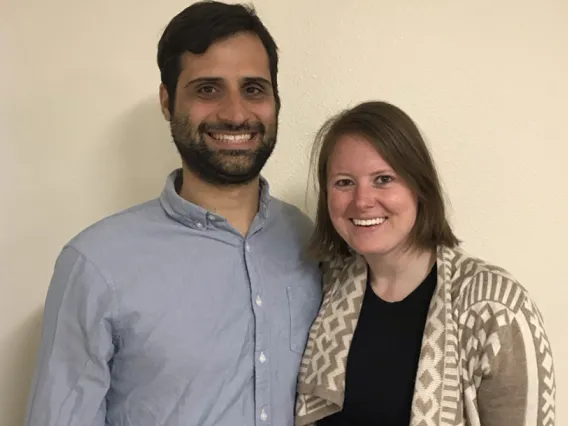
Drs. Ali Bramson and Michael Sori will be Assistant Professors at Purdue University!
Dr. Michael Sori and Dr. Ali Bramson are Postdocs in the Lunar and Planetary Laboratory at UArizona. Both accepted positions as Assistant Professors in the Department of Earth, Atmospheric, and Planetary Sciences at Purdue University.
Drs. Ali Bramson and Michael Sori will be Assistant Professors at Purdue University!
×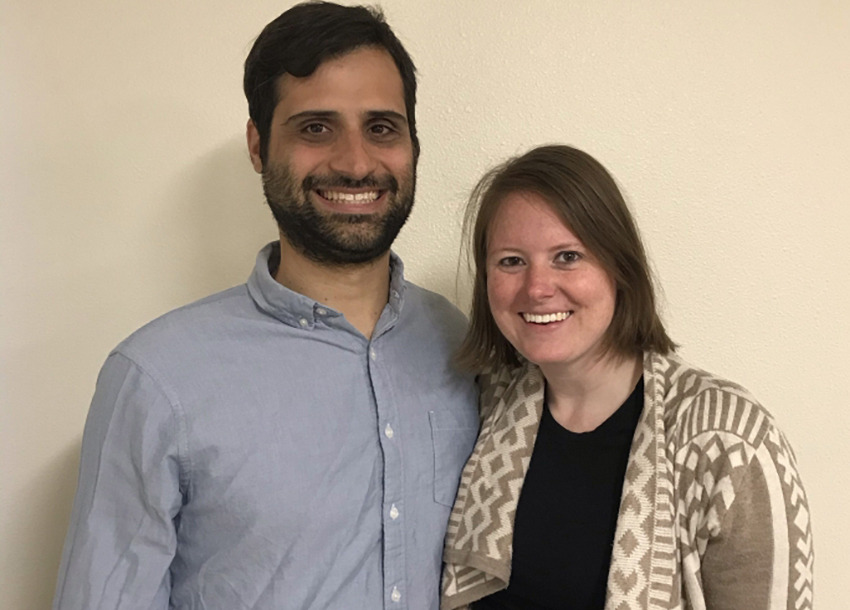
Written by Lauren Rowe - August 17, 2020
Dr. Michael Sori (Ph.D. in Planetary Sciences, Massachusetts Institute of Technology) and Dr. Ali Bramson (Ph.D. in Planetary Sciences, University of Arizona) are Postdoctoral Scholars in the Lunar and Planetary Laboratory (LPL) at the University of Arizona. Both have recently accepted positions as Assistant Professors in the Department of Earth, Atmospheric, and Planetary Sciences (EAPS) at Purdue University. Currently, under the training of Dr. Hamilton and Dr. Byrne, Dr. Sori contributes to the study of Mars and the Moon while also being involved in several NASA missions. Working with Dr. Carter, Dr. Bramson researches lava flows on the Moon with instruments onboard NASA’s Lunar Reconnaissance Orbiter spacecraft.
In Fall 2020 in the EAPS Department at Purdue University, Dr. Sori and Dr. Bramson will be teaching undergraduate and graduate courses in planetary geology while expanding their current research. Dr. Sori explained that his experience at the University of Arizona, including working with students in lab groups and supporting their thesis projects, has prepared him for the next step as an Assistant Professor.
Likewise, Dr. Bramson shared that through the LPL at the University of Arizona she got involved in active NASA spacecraft missions, which were crucial for her scientific interests, and led to great professional and academic opportunities. Dr. Bramson is particularly excited about the interdisciplinary EAPS Department where she will collaborate with scientists who use similar techniques, but also engage in other problems different from her training.
Outside of her research Bramson plays competitive ultimate frisbee. She recognizes the importance of having hobbies as a reminder of the benefits of teamwork and for overall mental health. Sori likes to travel and recently visited his 50th state. Together they have been on mission to prepare meals from all the countries of the world; so far they have made meals from 94 countries! They enjoy hiking with their dog at the Catalina State Park and Mount Lemmon and being part of the Tucson community. We congratulate and wish them the best as they start their positions as Assistant Professors at Purdue University.
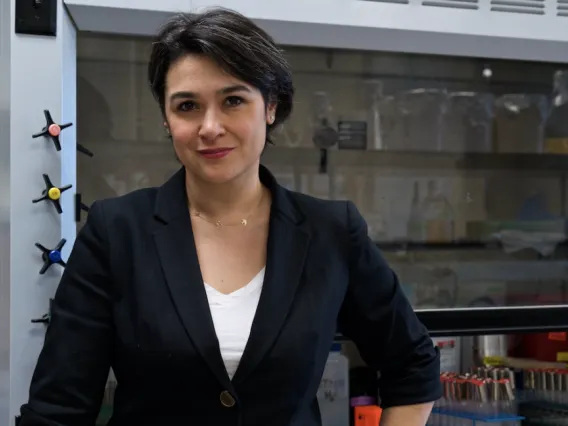
To Understand the Machinery of Life, a UArizona Scientist Breaks it on Purpose
By tinkering with some of life's oldest components, a group of astrobiologists led by UArizona's Betül Kaçar hope to find clues about how life emerged. In a recent paper, they report an unexpected discovery, hinting at an effect that prevents organisms from ever reaching evolutionary perfection.
To Understand the Machinery of Life, a UArizona Scientist Breaks it on Purpose
×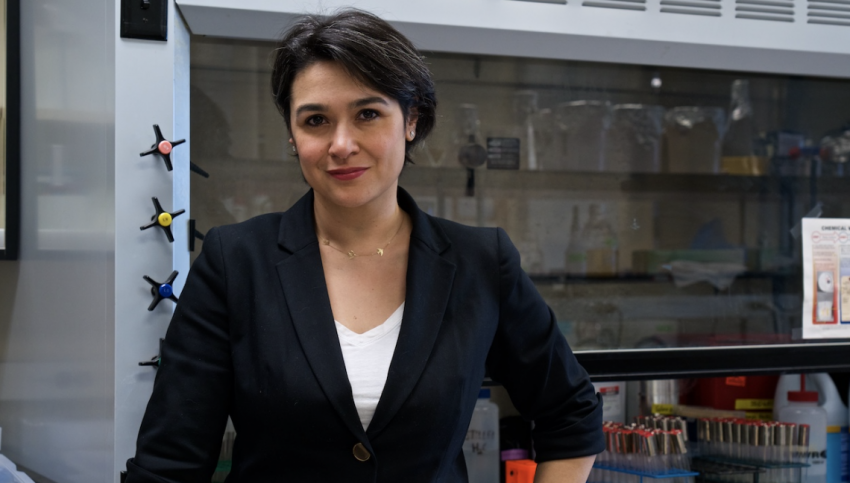
By Daniel Stolte, University Communications - August 13, 2020
"I'm fascinated with life, and that's why I want to break it."
This is how Betül Kaçar, an assistant professor at the University of Arizona with appointments in the Department of Molecular and Cellular Biology, Department of Astronomy and the Lunar and Planetary Laboratory, describes her research. What may sound callous is a legitimate scientific approach in astrobiology. Known as ancestral sequencing, the idea is to "resurrect" genetic sequences from the dawn of life, put them to work in the cellular pathways of modern microbes – think Jurassic Park but with extinct genes in place of dinosaurs, and study how the organism copes.
In a recent paper published in the Proceedings of the National Academy of Sciences, Kaçar's research team reports an unexpected discovery: Evolution, it seems, is not very good at multitasking.
Kaçar uses ancestral sequencing to find out what makes life tick and how organisms are shaped by evolutionary selection pressure. The insights gained may, in turn, offer clues as to what it takes for organic precursor molecules to give rise to life – be it on Earth or faraway worlds. In her lab, Kaçar specializes in designing molecules that act like tiny invisible wrenches, wreaking havoc with the delicate cellular machinery that allows organisms to eat, move and multiply – in short, to live.
Kaçar has focused her attention on the translation machinery, a labyrinthine molecular clockwork that translates the information encoded in the bacteria's DNA into proteins. All organisms – from microbes to algae to trees to humans – possess this piece of machinery in their cells.
The translational machinery is a vital component in the cells of all organisms. Having undergone very little change over billions of years of evolution, it has been referred to as "an evolutionary accident frozen in time." At its core is the ribosome (blue), which translates genetic information stored in RNA strands into proteins, the building blocks of life.National Science Foundation
"We approximate everything about the past based on what we have today," Kaçar said. "All life needs a coding system – something that takes information and turns it into molecules that can perform tasks – and the translational machinery does just that. It creates life's alphabet. That's why we think of it as a fossil that has remained largely unchanged, at least at its core. If we ever find life elsewhere, you bet that the first thing we'll look at is its information processing systems, and the translational machinery is just that."
So critical is the translational machinery to life on Earth that even over the course of more than 3.5 billion years of evolution, its parts have undergone little substantial change. Scientists have referred to it as "an evolutionary accident frozen in time."
"I guess I tend to mess with things I'm not supposed to," Kaçar said. "Locked in time? Let's unlock it. Breaking it would lead the cell to destruction? Let's break it."
The researchers took six different strains of Escherichia coli bacteria and genetically engineered the cells with mutated components of their translational machinery. They targeted the step that feeds the unit with genetic information by swapping the shuttle protein with evolutionary cousins taken from other microbes, including a reconstructed ancestor from about 700 million years ago.
"We get into the heart of the heart of what we think is one of the earliest machineries of life," Kaçar said. "We purposely break it a little, and a lot, to see how the cells deal with this problem. In doing this, we think we create an urgent problem for the cell, and it will fix that."
Next, the team mimicked evolution by having the manipulated bacterial strains compete with each other – like a microbial version of "The Hunger Games." A thousand generations later, some strains fared better than others, as was expected. But when Kaçar's team analyzed exactly how the bacteria responded to perturbations in their translational components, they discovered something unexpected: Initially, natural selection improved the compromised translational machinery, but its focus shifted away to other cellular modules before the machinery's performance was fully restored.
To find out why, Kaçar enlisted Sandeep Venkataram, a population genetics expert at the University of California, San Diego.
Venkataram likens the process to a game of whack-a-mole, with each mole representing a cellular module. Whenever a module experiences a mutation, it pops up. The hammer smashing it back down is the action of natural selection. Mutations are randomly spread across all modules, so that all moles pop up randomly.
"We expected that the hammer of natural selection also comes down randomly, but that is not what we found," he said. "Rather, it does not act randomly but has a strong bias, favoring those mutations that provide the largest fitness advantage while it smashes down other less beneficial mutations, even though they also provide a benefit to the organism."
In other words, evolution is not a multitasker when it comes to fixing problems.
"It seems that evolution is myopic," Venkataram said. "It focuses on the most immediate problem, puts a Band-Aid on and then it moves on to the next problem, without thoroughly finishing the problem it was working on before."
"It turns out the cells do fix their problems but not in the way we might fix them," Kaçar added. "In a way, it's a bit like organizing a delivery truck as it drives down a bumpy road. You can stack and organize only so many boxes at a time before they inevitably get jumbled around. You never really get the chance to make any large, orderly arrangement."
Why natural selection acts in this way remains to be studied, but what the research showed is that, overall, the process results in what the authors call "evolutionary stalling" – while evolution is busy fixing one problem, it does at the expense of all other issues that need fixing. They conclude that at least in rapidly evolving populations, such as bacteria, adaptation in some modules would stall despite the availability of beneficial mutations. This results in a situation in which organisms can never reach a fully optimized state.
"The system has to be capable of being less than optimal so that evolution has something to act on in the face of disturbance – in other words, there needs to be room for improvement," Kaçar said.
Kaçar believes this feature of evolution may be a signature of any self-organizing system, and she suspects that this principle has counterparts at all levels of biological hierarchy, going back to life's beginnings, possibly even to prebiotic times when life had not yet materialized.
With continued funding from the John Templeton Foundation and NASA, the research group is now working on using ancestral sequencing to go back even further in time, Kaçar said.
"We want to strip things down even more and create systems that start out as what we would consider pre-life and then transition into what we consider life."
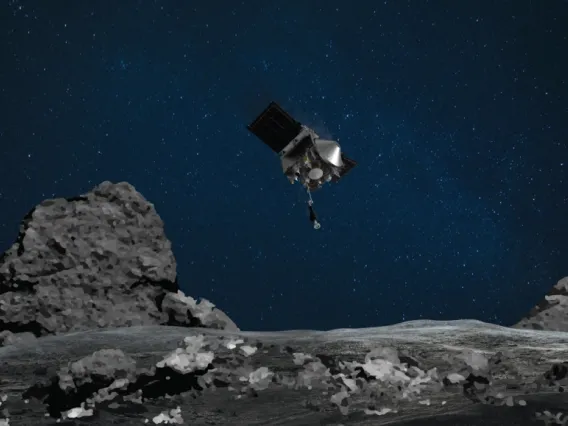
Successful Second Rehearsal Puts OSIRIS-REx on Path to Asteroid Sample Collection
During its final practice run in preparation for sample collection at asteroid Bennu, the OSIRIS-REx spacecraft approached the surface closer than ever before.
Successful Second Rehearsal Puts OSIRIS-REx on Path to Asteroid Sample Collection
×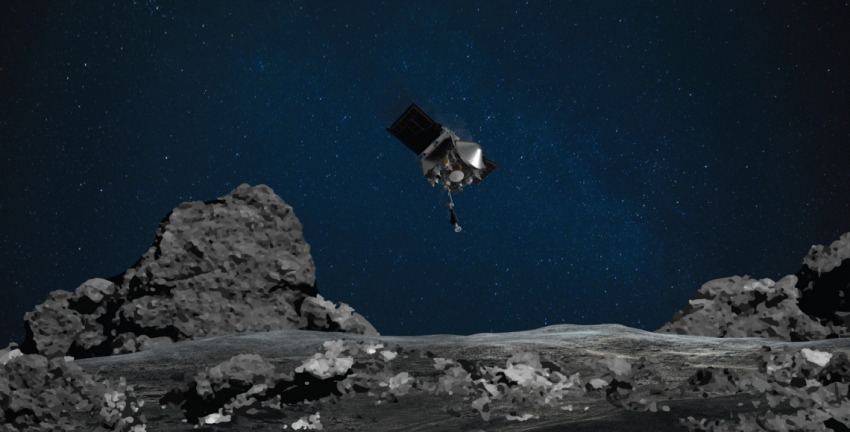
By Brittany Enos, Lunar and Planetary Laboratory - August 12, 2020
NASA's first asteroid-sampling spacecraft completed its second successful sample collection rehearsal on Aug. 11 and is now ready for the main event – touching down on asteroid Bennu's surface in October.
During its final practice run of the sampling sequence, the spacecraft of the University of Arizona-led OSIRIS-REx mission reached an approximate altitude of 131 feet, or 40 meters, over sample site Nightingale before executing a back-away burn. Nightingale, OSIRIS-REx's primary sample collection site, is located in a crater in Bennu's northern hemisphere.
The approximately four-hour matchpoint rehearsal took the spacecraft through the first three of the sampling sequence’s four maneuvers: the orbit departure burn, the checkpoint burn and the matchpoint burn. Checkpoint is the point where the spacecraft autonomously checks its position and velocity before adjusting its trajectory down toward the event's third maneuver. Matchpoint is the moment when the spacecraft matches Bennu's rotation in order to fly in tandem with the asteroid surface, directly above the sample site, before touching down on the targeted spot.
Four hours after departing its 0.6-mile safe-home orbit, OSIRIS-REx performed the checkpoint maneuver at an approximate altitude of 410 feet above Bennu's surface. From there, the spacecraft continued to descend for another eight minutes to perform the matchpoint burn. After descending on this new trajectory for another three minutes, the spacecraft reached an altitude of approximately 131 feet – the closest the spacecraft has ever been to Bennu – and then performed a back-away burn to complete the rehearsal.
During the rehearsal, the spacecraft successfully deployed its sampling arm, the Touch-And-Go Sample Acquisition Mechanism, from its folded, parked position out to the sample collection configuration. Additionally, some of the spacecraft's instruments collected science and navigation images and made spectrometry observations of the sample site, as will occur during the sample collection event. These images and data were downlinked to Earth after the event’s conclusion.
Because the spacecraft and Bennu are currently about 179 million miles from Earth, it takes approximately 16 minutes for the spacecraft to receive the radio signals used to command it. This time lag prevented live commanding of flight activities from the ground during the rehearsal. As a result, the spacecraft performed the entire rehearsal sequence autonomously. Prior to the rehearsal's start, the OSIRIS-REx team uplinked all of the event's commands to the spacecraft and then provided the "go" command to begin the event. The actual sample collection event in October will be conducted the same way.
This second rehearsal provided the mission team with practice navigating the spacecraft through the first three maneuvers of the sampling event and was an opportunity to verify that the spacecraft's imaging, navigation and ranging systems operated as expected during the first part of the descent sequence.
The rehearsal also confirmed that OSIRIS-REx's Natural Feature Tracking guidance system accurately estimated the spacecraft's trajectory after the matchpoint burn, which is the final maneuver before the sample collection head contacts Bennu's surface. This rehearsal was also the first time that the spacecraft's on-board hazard map was employed. The hazard map delineates areas that could potentially harm the spacecraft. If the spacecraft detects that it is on course to touch a hazardous area, it will autonomously back away once it reaches an altitude of 16 feet. While OSIRIS-REx did not fly that low during the rehearsal, it did employ the hazard map to assess whether its predicted touchdown trajectory would have avoided surface hazards, and found that the spacecraft's path during the rehearsal would have allowed for a safe touchdown on sample site Nightingale.
During the last minutes of the spacecraft's descent, OSIRIS-REx also collected new, high-resolution navigation images for the Natural Feature Tracking guidance system. These detailed images of Bennu's landmarks will be used for the sampling event and will allow the spacecraft to accurately target a very small area.
"Many important systems were exercised during this rehearsal – from communications, spacecraft thrusters, and most importantly, the onboard Natural Feature Tracking guidance system and hazard map," said OSIRIS-REx principal investigator Dante Lauretta of the University of Arizona's Lunar and Planetary Laboratory. "Now that we've completed this milestone, we are confident in finalizing the procedures for the TAG event. This rehearsal confirmed that the team and all of the spacecraft's systems are ready to collect a sample in October."
The mission team has spent the last several months preparing for matchpoint rehearsal while maximizing remote work as part of the COVID-19 response. On the day of rehearsal, a limited number of personnel monitored the spacecraft’s telemetry from Lockheed Martin Space's facility, NASA's Goddard Space Flight Center and the University of Arizona, taking appropriate safety precautions while the rest of the team performed their roles remotely.
The spacecraft will travel all the way to the asteroid's surface during its first sample collection attempt, scheduled for Oct. 20. During this event, OSIRIS-REx's sampling mechanism will touch Bennu's surface for several seconds, fire a charge of pressurized nitrogen to disturb the surface and collect a sample before the spacecraft backs away. The spacecraft is scheduled to return the sample to Earth on Sept. 24, 2023.
NASA's Goddard Space Flight Center in Greenbelt, Maryland, provides overall mission management, systems engineering, and the safety and mission assurance for OSIRIS-REx. Lauretta is the principal investigator, and UArizona also leads the science team and the mission's science observation planning and data processing. Lockheed Martin Space in Denver built the spacecraft and provides flight operations. Goddard and KinetX Aerospace are responsible for navigating the OSIRIS-REx spacecraft. OSIRIS-REx is the third mission in NASA's New Frontiers Program, which is managed by NASA's Marshall Space Flight Center in Huntsville, Alabama, for the agency’s Science Mission Directorate in Washington, D.C.
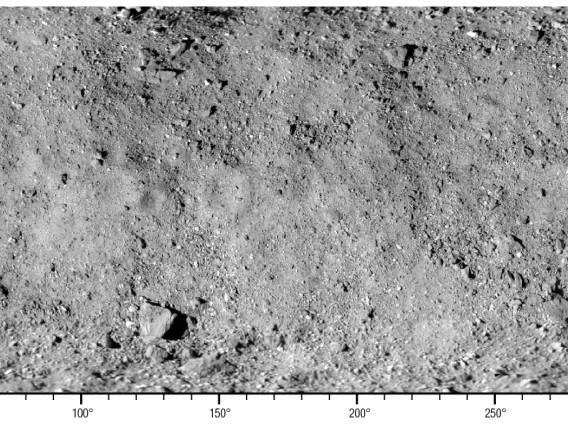
Mapping the Solar System: From the Moon to Bennu
The University of Arizona has played a role in imaging and mapping most major objects in the solar system. Now, it adds the asteroid Bennu to the list. The Bennu Global Mosaic, as the complete map of the asteroid is called, is the highest resolution map of any celestial body.
Mapping the Solar System: From the Moon to Bennu
×
By Mikayla Mace, University Communications - July 15, 2020
As NASA's OSIRIS-REx spacecraft prepares to briefly touch down and collect a sample from the asteroid Bennu in October, the mission's science team, led by the University of Arizona, has worked meticulously to create the highest resolution global map of any planetary body, including Earth. The endeavor is the latest in the university's long history of celestial imaging and mapping – one that began with the first lunar landings.
The team stitched together 2,155 images – containing pixels that translate to two square inches on the surface – to create the Bennu Global Mosaic.
"This is the finest spatial scale we've ever mapped of a planetary object," said Daniella DellaGiustina, OSIRIS-REx image processing lead scientist. "It's also unprecedented in the way we used it. Typically, when NASA chooses a landing site for an upcoming mission, they have an orbiter doing reconnaissance of the surface long before a separate mission contacts the surface. But we went to Bennu without that luxury. This paradigm of doing every step in close succession is unique and made things demanding."
The spacecraft collected the images at distances ranging from 2.2 to 2.9 miles above the asteroid's surface between March 21 and April 11, 2019. The mosaic was completed in February.
The detailed view of Bennu was used by the mission team during its selection of the primary and backup sample collection sites, dubbed Nightingale and Osprey, respectively.
The full-sized version of the mosaic has been downloaded over 52,810 times since it was released in February.
Making a Mosaic
There are a couple of important criteria that a useful map of Bennu's surface needed to meet.
"It needed to contain minimal distortion and good lighting to get sense for texture and relief across surface," DellaGiustina said.
Carina Bennett was up for the task. She has a background in photography, film and art, having earned a Bachelor of Arts in media arts and creative writing from UArizona and a Master of Arts in film and video production from the University of Iowa. She worked as a videographer in University Communications at UArizona nearly 10 years ago while simultaneously enrolled in computer science courses. Her computer science degree and the connections she forged while working for the university brought her to her first job on the OSIRIS-REx mission. She is now a senior engineer on the mission's image processing team.
To create the Bennu Global Mosaic, the team first had to capture images of the surface using the PolyCam instrument.
"PolyCam, one of the UArizona-developed cameras onboard the spacecraft, captured 7,000 images, and I narrowed those down to just over 2,100," Bennett said. "I looked for images that had the best geometry, meaning the best angle between the spacecraft and the part of the asteroid we were imaging and the best angle between the sun and that area."
The spacecraft snapped photos from three predetermined orbital angles – in the northern hemisphere, at the equator and in the southern hemisphere – that made sure there were clear views of the entire asteroid surface and optimized the shadows of Bennu's features. While maps typically want to eliminate shadows, they were needed in this case to make the surface features pop.
"We wanted a little shadow, but not too much and not weird angles. It was all just very meticulously planned," Bennett said.
Then, using a 3D model of the asteroid that was created using a program that inferred the shape based on multiple photo angles, Bennett and her team overlaid the images.
"We took a few images and manually matched them to sites scattered across the 3D shape model," she said. "If they're not lined up perfectly, they seem to wiggle when we toggled between the two. We carefully nudged the photos into place until we got a perfect match. Then, to lay the rest of the images, we used computer algorithms, which automatically matched surface features."
This is where Bennett's photography and graphic design background came in.
"One thing I can't do is use Photoshop. If we were to do that, it would compromise the scientific integrity. People get scientific information from brightness of the pixels, for example, so we don't want to smudge away the science," Bennett said. "Instead, I had to carefully choose where to divide the images. I cut through things like shadows or along crater rims instead of down the middle of a rock that was imaged from two different viewing angles. By carefully tracing the topography and matching images together like puzzle pieces, I was able to make the map a lot more seamless."
The final global mosaic can serve as a base map to give context to future scientific data.
"When scientists collect spectral (light) data reflected and emitted from Bennu to determine its composition, it just looks like squiggly lines and latitude and longitude coordinates," Bennett said. "So being able to then look at the corresponding location and features on the map is extremely helpful in interpreting that data."
Individual images also aren't as useful as a high-definition map, DellaGiustina said.
"This can provide data to unlock what kind of global patterns exist on Bennu and provide context to other datasets," she said.
The global mosaic was also used for a citizen science project where anyone with an internet connection could map and measure Bennu's boulders, which will contribute to a global boulder census.
Future mosaics, which will focus on smaller portions of the asteroid and be higher resolution, will be used for navigation of the primary and secondary sample sites.
Launching a Legacy
"The University of Arizona has extensive history of imaging other objects in the solar system," DellaGiustina said. "All that heritage was brought to bear when we designed the cameras for the OSIRIS-REx mission."
When President John F. Kennedy announced in 1961 that Americans would walk on the moon by the end of the 1960s, a small group of UArizona researchers was among the few already studying the moon professionally.
The team members imaged and mapped the lunar surface, which allowed them to understand the moon's geology and allowed NASA to choose landing sites for future robotic and Apollo missions. Gerard Kuiper, the father of modern-day planetary science, led the team and established the Lunar and Planetary Laboratory at UArizona, where he served as department head.
Since then, UArizona has played prominent roles in NASA missions that mapped objects across the solar system. The Pioneer missions of the 70s mapped Jupiter and Saturn, the Voyager probes a few years later took the only close-up images of Neptune and Uranus, and the Cassini spacecraft snapped photos of Saturn while the Huygens probe captured images of the moon Titan.
The university also leads the High-Resolution Imaging Science Experiment, or HiRISE, which captures stunning photos of the Martian surface from onboard NASA's Mars Reconnaissance Orbiter.
The cameras onboard the UArizona-led OSIRIS-REx mission were developed at the university. The PolyCam instrument used to capture the images for the mosaic has an adjustable focus, capable of imaging Bennu from millions of miles away to less than a mile from its surface.
"Because of our long history of developing spaceflight payloads and cameras, we've also gotten good and developing software to process all of those images," DellaGiustina said. "For Bennu, in particular, we worked on establishing – in collaboration with Astrogeology Science Center, USGS (U.S. Geological Survey) in Flagstaff – a suite of image processing software able to handle irregularly shaped objects and translate them into maps. Maps usually project spherical objects, but Bennu was a unique challenge because it's diamond shaped."
The team effort included the work of about a dozen people who helped tie images to each other and to the model of the asteroid, and around 10 people who helped plan the image data collection and send commands to the cameras onboard OSIRIS-REx.
"We still have a lot of work to do," Bennett said. "We're planning on sampling in October of this year, so much of our work now is making sure we're prepared."

NASA's OSIRIS-REx Discovers Sunlight Can Crack Rocks on Asteroid Bennu
The spacecraft of the LPL-led OSIRIS-REx mission has documented the first direct evidence of erosion driven by harsh temperatures between daytime and nighttime. Evidence of thermal fracturing on the asteroid can help scientists learn about the geologic history not only on Bennu, but on other planetary surfaces as well.
NASA's OSIRIS-REx Discovers Sunlight Can Crack Rocks on Asteroid Bennu
×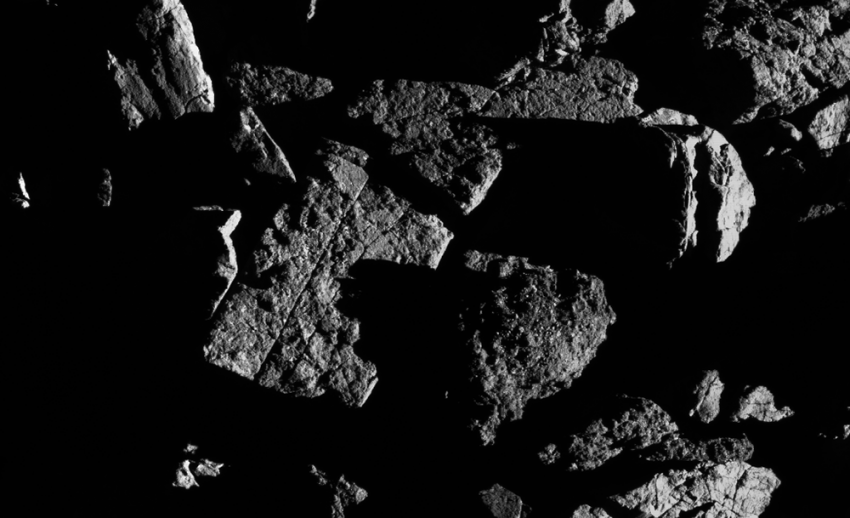
By University Communications - June 9, 2020
Asteroids don't just sit there doing nothing as they orbit the sun. They get bombarded by meteoroids, blasted by space radiation and now, for the first time, scientists are seeing evidence that even a little sunshine can wear them down.
Rocks on asteroid Bennu appear to be cracking as sunlight heats them up during the day and they cool down at night, according to images from NASA's OSIRIS-REx spacecraft.
"This is the first time evidence for this process, called thermal fracturing, has been definitively observed on an object without an atmosphere," said University of Arizona alumna Jamie Molaro of the Planetary Science Institute and lead author of a paper in Nature Communications. "It is one piece of a puzzle that tells us what the surface used to be like, and what it will be like millions of years from now."
"Like any weathering process, thermal fracturing causes the evolution of boulders and planetary surfaces over time – from changing the shape and size of individual boulders, to producing pebbles or fine-grained regolith, to breaking down crater walls," said OSIRIS-REx principal investigator Dante Lauretta of the University of Arizona. "How quickly this occurs relative to other weathering processes tells us how and how quickly the surface has changed."
Rocks expand when sunlight heats them during the day and contract as they cool down at night, causing stress that forms cracks that grow slowly over time. Scientists have thought for a while that thermal fracturing could be an important weathering process on airless objects like asteroids because many experience extreme temperature differences between day and night, compounding the stress. For example, daytime highs on Bennu can reach almost 127 degrees Celsius, or about 260 degrees Fahrenheit, and nighttime lows plummet to about minus 73 degrees Celsius, or nearly minus 100 degrees Fahrenheit. However, many of the telltale features of thermal fracturing are small, and before OSIRIS-REx got close to Bennu, the high-resolution imagery required to confirm thermal fracturing on asteroids didn't exist.
The mission team found features consistent with thermal fracturing using the spacecraft's OSIRIS-REx Camera Suite, which can see features on Bennu smaller than one centimeter, or almost 0.4 inches. It found evidence of exfoliation, where thermal fracturing likely caused small, thin layers – between 1 and 10 centimeters – to flake off of boulder surfaces. The spacecraft also produced images of cracks running through boulders in a north-south direction, along the line of stress that would be produced by thermal fracturing on Bennu.
Other weathering processes can produce similar features, but the team's analysis ruled them out. For example, rain and chemical activity can produce exfoliation, but Bennu has no atmosphere to produce rain. Rocks squeezed by tectonic activity can also exfoliate, but Bennu is too small for such activity. Meteoroid impacts do occur on Bennu and can certainly crack rocks, but they would not cause the even erosion of layers from boulder surfaces that were seen. Also, there's no sign of impact craters where the exfoliation is occurring.
Additional studies of Bennu could help determine how rapidly thermal fracturing is wearing down the asteroid, and how it compares to other weathering processes.
"We don't have good constraints yet on breakdown rates from thermal fracturing, but we can get them now that we can actually observe it for the first time in situ," said OSIRIS-REx project scientist Jason Dworkin of NASA's Goddard Space Flight Center in Greenbelt, Maryland. "Laboratory measurements on the properties of the samples returned by the spacecraft in 2023 will help us learn more about how this process works."
Another area of research is how thermal fracturing affects our ability to estimate the age of surfaces. In general, the more weathered a surface is, the older it is. For example, a region with a lot of craters is likely to be older than an area with few craters, assuming impacts happen at a relatively constant rate across an object. However, additional weathering from thermal fracturing could complicate an age estimate, because thermal fracturing is going to happen at a different rate on different bodies, depending on things like their distance from the sun, the length of their day and the composition, structure and strength of their rocks. On bodies where thermal fracturing is efficient, it may cause crater walls to break down and erode faster. This would make the surface look older according to the cratering record, when in fact it is actually younger. Or the opposite could occur. More research on thermal fracturing on different bodies is needed to start to get a handle on this, Molaro said.
The research was funded by NASA's OSIRIS-REx Participating Scientist program as well as the OSIRIS-REx asteroid sample return mission. NASA's Goddard Space Flight Center in Greenbelt, Maryland, provides overall mission management, systems engineering, and the safety and mission assurance for OSIRIS-REx. The University of Arizona leads the science team and the mission's science observation planning and data processing. Lockheed Martin Space in Denver built the spacecraft and is providing flight operations. Goddard and KinetX Aerospace are responsible for navigating the OSIRIS-REx spacecraft. OSIRIS-REx is the third mission in NASA's New Frontiers Program, which is managed by NASA's Marshall Space Flight Center in Huntsville, Alabama, for the agency's Science Mission Directorate in Washington.
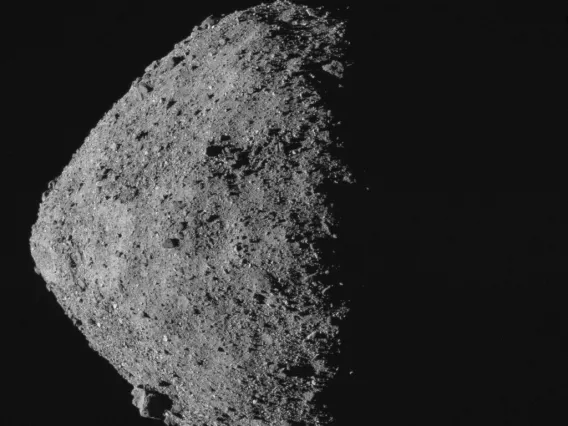
Asteroids Bennu and Ryugu May Have Formed Directly From Collision in Space
Scientists from the OSIRIS-REx and Hayabusa2 teams have a new theory about why the asteroids Bennu and Ryugu have their signature "spinning-top" shapes.
Asteroids Bennu and Ryugu May Have Formed Directly From Collision in Space
×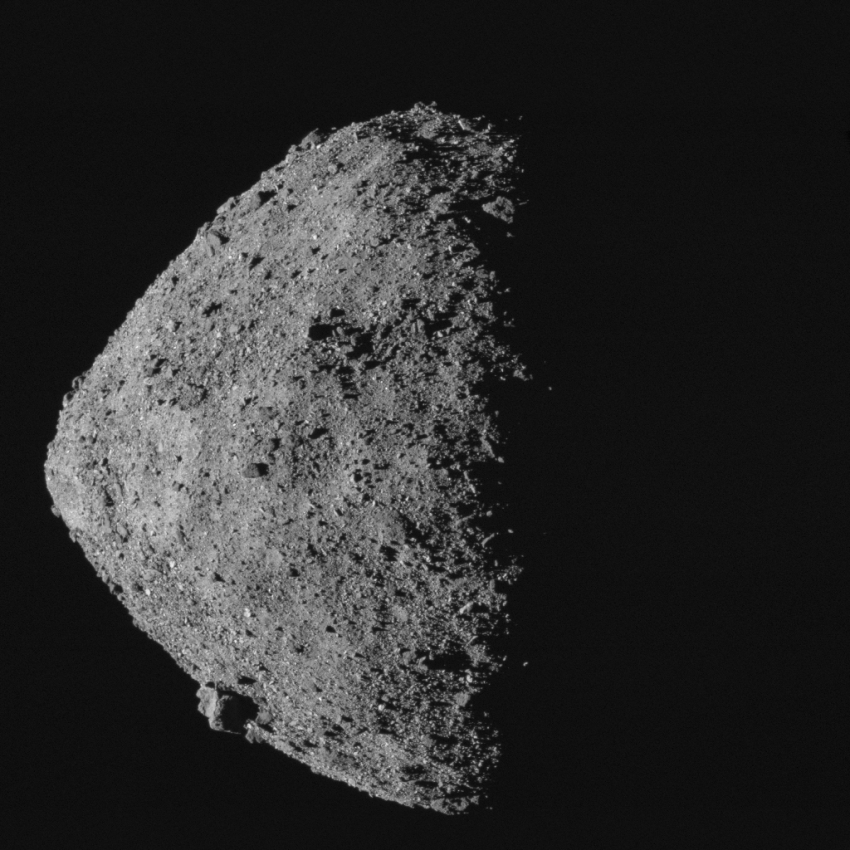
By Brittany Enos, Lunar and Planetary Laboratory - June 1, 2020
Scientists with NASA's first asteroid sample return mission, OSIRIS-REx, are gaining a new understanding of asteroid Bennu's carbon-rich material and signature "spinning-top" shape. The team, led by the University of Arizona, has discovered that the asteroid's shape and hydration levels provide clues to the origins and histories of this and other small bodies.
Bennu, the target asteroid for the OSIRIS-REx mission, and Ryugu, the target of the Japan Aerospace Exploration Agency's Hayabusa2 asteroid sample return mission, are composed of fragments of larger bodies that shattered upon colliding with other objects. The small fragments reaccumulated to form an aggregate body. Bennu and Ryugu may actually have formed in this way from the same original shattered parent body. Now, scientists are looking to discover what processes led to specific characteristics of these asteroids, such as their shape and mineralogy.
Bennu and Ryugu are both classified as "spinning-top" asteroids, which means they have a pronounced equatorial ridge. Until now, scientists thought that this shape formed as the result of thermal forces, called the YORP effect. The YORP effect increases the speed of the asteroid's spin, and over millions of years, material near the poles could have migrated to accumulate on the equator, eventually forming a spinning-top shape – meaning that the shape would have formed relatively recently.
However, in a new paper published in Nature Communications, scientists from the OSIRIS-REx and Hayabusa2 teams argue that the YORP effect may not explain the shape of either Bennu or Ryugu. Both asteroids have large impact craters on their equators, and their size suggests that these craters are some of Bennu's oldest surface features. Since the craters cover the equatorial ridges, their spinning-top shapes must also have been formed much earlier.
"Using computer simulations that model the impact that broke up Bennu's parent body, we show that these asteroids either formed directly as top-shapes, or achieved the shape early after their formation in the main asteroid belt," said Ronald Ballouz, co-lead author and OSIRIS-REx postdoctoral research associate at the UArizona. "The presence of the large equatorial craters on these asteroids, as seen in images returned by the spacecraft, rules out that the asteroids experienced a recent re-shaping due to the YORP effect. We would expect these craters to have disappeared with a recent YORP-induced re-shaping of the asteroid."
In addition to their shapes, Bennu and Ryugu also both contain water-bearing surface material in the form of clay minerals. Ryugu's surface material is less water-rich than Bennu's, which implies that Ryugu's material experienced more heating at some point.
Assuming Bennu and Ryugu formed simultaneously, the paper explores two possible explanations for the different hydration levels of the two bodies based on the team's computer simulations. One hypothesis suggests that when the parent asteroid was disrupted, Bennu formed from material closer to the original surface, while Ryugu contained more material from near the parent body's original center. Another possible explanation for the difference in hydration levels is that the fragments experienced different levels of heating during the parent asteroid's disruption. If this is the case, Ryugu's source material is likely from an area near the impact point, where temperatures were higher. Bennu's material would have come from a region that didn't undergo as much heating, and was likely farther from the point of impact. Analysis of the returned samples and further observational analysis of the asteroids' surfaces will provide a clearer idea of the possible shared history of the two asteroids.
"These simulations provide valuable new insights into how Bennu and Ryugu formed," said Dante Lauretta, OSIRIS-REx principal investigator and UArizona professor of planetary sciences. "Once we have the returned samples of these two asteroids in the lab, we may be able to further confirm these models, possibly revealing the true relationship between the two asteroids."
Scientists anticipate that the samples will also provide new insights into the origins, formation and evolution of other carbonaceous asteroids and meteorites. The Japan Aerospace Exploration Agency's Hayabusa2 mission is currently making its way back to Earth, and is scheduled to deliver its samples of Ryugu late this year. The OSIRIS-REx mission will perform its first sample collection attempt at Bennu on Oct. 20 and will deliver its samples to Earth on Sep. 24, 2023.
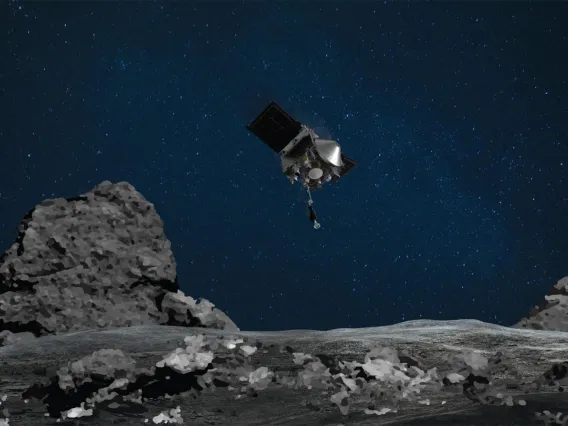
OSIRIS-REx Asteroid Sample Collection Set for October 20
The new date allows the team more time to assess Bennu's unexpectedly rugged terrain. The event will mark NASA's first-ever asteroid sample collection.
OSIRIS-REx Asteroid Sample Collection Set for October 20
×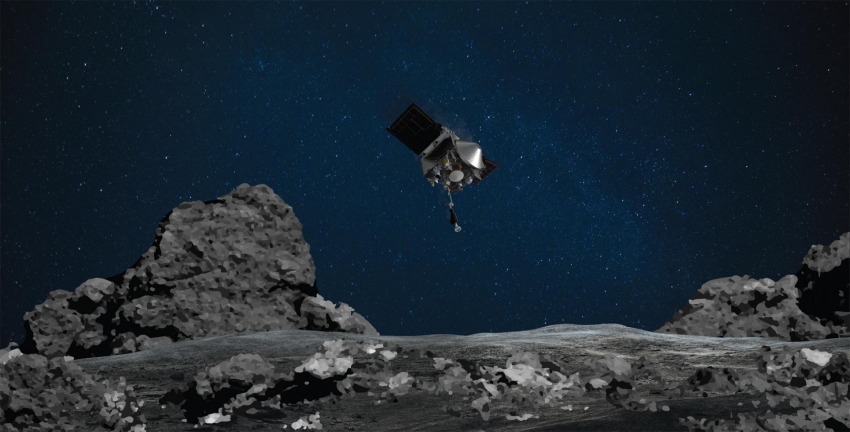
By Mikayla Mace, University Communications - May 21, 2020
After more than a decade of work and much anticipation, the University of Arizona-led OSIRIS-REx mission will swipe a sample from the asteroid Bennu's rocky surface on Oct. 20 from the Nightingale sample site.
The mission team successfully completed a first rehearsal last month, and on Tuesday, NASA approved a second rehearsal date of Aug. 11 and the Touch-and-Go, or TAG, sample collection event in October.
The original target date for sample collection was planned for late August, but the new Oct. 20 date will allow the team more time to prepare, in the wake of the COVID-19 pandemic.
"From the project's inception, and from experience on previous missions, the principal investigator, Dante Lauretta, myself and the team laid out a methodical schedule with strategically placed schedule margin with the knowledge that we need to accommodate unexpected events along the way," said Heather Enos, deputy principal investigator for the OSIRIS-REx mission. "The fact that this is such a long mission means there's more opportunity to experience the unexpected. We knew that and planned for it. I'm in awe of how adaptable this team is."
OSIRIS-REx has three major partners: Lockheed Martin, NASA's Goddard Space Flight Center and the University of Arizona. They're currently using remote communications, Enos said, but for big operations, such as rehearsal and sample collection, there is a lot of value in having your team in one location.
After the first rehearsal on April 14, the team decided to schedule more time between the second rehearsal and sample collection.
"We want to provide the team more time to see if there's anything we can to do improve the mission's probability of success," Enos said. "We gave them two more weeks between rehearsal and sample collection. We were expecting a 25-meter (about 80-foot) target radius, but we quickly learned that Bennu's rocky surface would only allow for two to four meters (less than 14 feet) to work with."
The OSIRIS-REx spacecraft arrived at the asteroid Bennu in December 2018 and has since been surveying and studying the asteroid from orbit. The mission is scheduled to leave Bennu in March 2021 and return to Earth on Sept. 24, 2023.
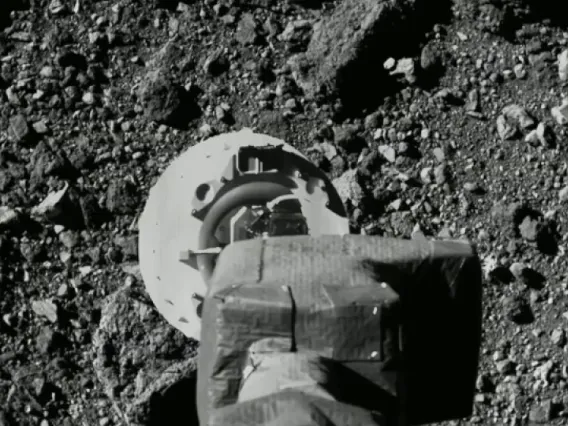
UArizona Cameras Capture Asteroid Close-Up During OSIRIS-REx Rehearsal
The spacecraft of the LPL-led OSIRIS-REx asteroid sample return mission executed a series of maneuvers that brought it within a mere 200 feet of its designated sampling location on the surface of Bennu.
UArizona Cameras Capture Asteroid Close-Up During OSIRIS-REx Rehearsal
×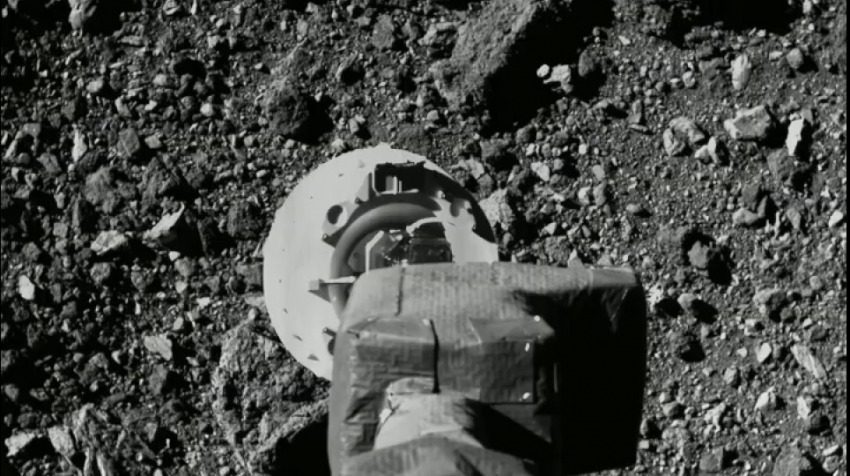
By Daniel Stolte, University Communications - April 21, 2020
A carefully choreographed dance on April 14 brought the spacecraft of the University of Arizona-led OSIRIS-REx asteroid sample return mission within just over 200 feet of the surface of the asteroid Bennu – closer than ever before.
During the maneuver, which marked the first rehearsal of the NASA mission's asteroid sample collection, the spacecraft engaged in a series of thruster burns and repositioning maneuvers to go through the exact same motions that planners mapped out for the mission's sample collection event, slated for late summer.
A series of images captured by the spacecraft's SamCam, one of several cameras designed and built at the University of Arizona's Lunar and Planetary Laboratory, shows the spacecraft's field of view as it approaches, hovers and then moves away from Bennu's surface.
The images were recorded over a 10-minute span between the execution of the rehearsal's checkpoint burn, approximately 394 feet above the surface, and the completion of the back-away burn, which occurred approximately 213 feet above the surface. During such burns, the spacecraft fires its thrusters in very precise and programmed sequences to maneuver in space.
"The goal of this checkpoint rehearsal is to make sure we get through the first two maneuvers needed to accomplish the sampling, and then safely back away," says Dani DellaGiustina, lead image processing scientist for the OSIRIS-REx mission. "What we're seeing here is the spacecraft as it approaches Bennu's surface, and once the spacecraft executes its checkpoint maneuver to initiate its descent, it pulls away. The image sequence captures that entire event."
During the April 14 rehearsal, the spacecraft – operating autonomously more than 140 million miles from Earth – deployed its sampling arm, called the Touch-And-Go Sample Acquisition Mechanism, or TAGSAM, which folded out from its parked position and extended to 11 feet. The arm has a round sampler head at the end, designed to collect a sample of loose surface material, called regolith, from Bennu.
During the touch-and-go sample collection event later this summer, the sampler head will be extended toward Bennu, and the momentum of the spacecraft's slow, downward trajectory will push it against the asteroid's surface for about five seconds—just long enough to obtain a sample. At contact, nitrogen gas will blow onto the surface to roil up dust and small pebbles, which will then be captured in the TAGSAM head.
The new series of images was taken as OSIRIS-REx swoops down toward Bennu's surface, with the arm and attached sample-collection head visible in the central part of the image frames. As it gets closer, the relatively clear, dark patch of Bennu's sample site, dubbed Nightingale, becomes visible. Just below it, a large, dark boulder, measuring 43 feet long, can be seen as the spacecraft approaches. The sequence was created using over 30 images taken by the spacecraft's SamCam camera. For context, the images are oriented with Bennu's west at the top. In other words, the asteroid's latitudinal lines would run vertically through the image.
"We're moving much more slowly than the animated image provides a sense for, and the majority of the movement you see is actually Bennu rotating underneath us," DellaGiustina said.
During the rehearsal, the spacecraft's suite of electronic eyes took images about every 20 seconds and sent them back to Earth. As soon as they arrived, DellaGiustina and her team got to work.
"I was scrolling through the images very quickly to see how much movement there was between the frames," she said. "Toward the end, when Nightingale came into view, it was so satisfying to see that right where we expected it to be before we backed off."
To create the animated sequence, DellaGiustina's team applied software algorithms, including components custom made by the mission team, to process them and stitch 30 frames together into the animated GIF.
"We don't use SamCam very often, because the imager was developed specifically to document the sampling event," she said. "To see SamCam in action, and to see it is doing exactly what it was designed to do, is very satisfying."
DellaGiustina said there really weren't any surprises during the checkpoint rehearsal.
"We've been planning this event for so long that all of us had a very concrete idea in our minds (of the checkpoint rehearsal), so you could say the only surprise was the fact that we saw exactly what we expected," DellaGiustina says. "I think that's a testament to our navigation team doing an extraordinary job."
The spacecraft is slated to go for the touch-and-go maneuver on Aug. 25, when it will gently descend onto its surface and collect the largest sample of extraterrestrial material since the Apollo moon landings.
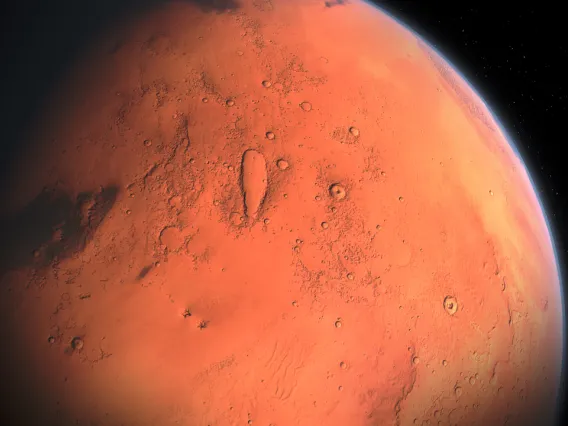
A Martian Mash Up: Meteorites Tell Story of Mars' Water History
LPL researchers probed Martian meteorites to reconstruct Mars’ chaotic history. Their findings suggest that Mars might not have had a global magma ocean.
A Martian Mash Up: Meteorites Tell Story of Mars' Water History
×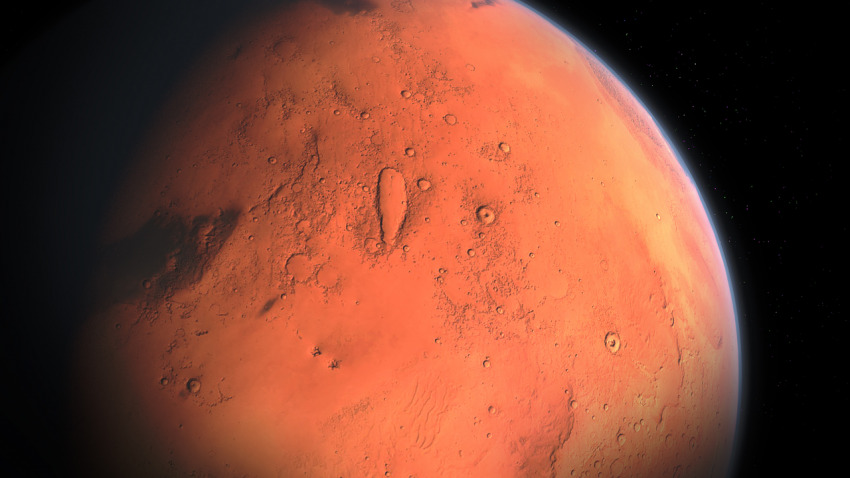
By Mikayla Mace, University Communications - March 30, 2020
In Jessica Barnes' palm is an ancient, coin-sized mosaic of glass, minerals and rocks as thick as a strand of wool fiber. It is a slice of Martian meteorite, known as Northwest Africa 7034 or Black Beauty, that was formed when a huge impact cemented together various pieces of the Martian crust.
Barnes is an assistant professor of planetary sciences in the University of Arizona Lunar and Planetary Laboratory. She and her team chemically analyzed the Black Beauty meteorite and the infamous Allan Hills 84001 meteorite – controversial in the 1990s for allegedly containing Martian microbes – to reconstruct Mars' water history and planetary origins.
Their analysis, published today in Nature Geoscience, showed that Mars likely received water from at least two vastly different sources early in its history. The variability the researchers found implies that Mars, unlike Earth and the moon, never had an ocean of magma completely encompassing the planet.
"These two different sources of water in Mars' interior might be telling us something about the kinds of objects that were available to coalesce into the inner, rocky planets," Barnes said.
Two distinct planetary precursors with vastly different water contents could have collided and never fully mixed, she said. "This context is also important for understanding the past habitability and astrobiology of Mars."
Reading the Water
"A lot of people have been trying to figure out Mars' water history," Barnes said. "Like, where did water come from? How long was it in the crust (surface) of Mars? Where did Mars' interior water come from? What can water tell us about how Mars formed and evolved?"
Barnes and her team were able to piece together Mars' water history by looking for clues in two types, or isotopes, of hydrogen. One hydrogen isotope contains one proton in its nucleus; this is sometimes called "light hydrogen." The other isotope is called deuterium, which contains a proton and a neutron in the nucleus; this is sometimes referred to as "heavy hydrogen." The ratio of these two hydrogen isotopes signals to a planetary scientist the processes and possible origins of water in the rocks, minerals and glasses in which they're found.
Meteorite Mystery
For about 20 years, researchers have been recording the isotopic ratios from Martian meteorites, and their data were all over the place. There seemed to be little trend, Barnes said.
Water locked in Earth rocks is what's called unfractionated, meaning it doesn't deviate much from the standard reference value of ocean water – a 1:6,420 ratio of heavy to light hydrogen. Mars' atmosphere, on the other hand, is heavily fractionated – it is mostly populated by deuterium, or heavy hydrogen, likely because the solar wind stripped away the light hydrogen. Measurements from Martian meteorites – many of which were excavated from deep within Mars by impact events – ran the gamut between Earth and Mars' atmosphere measurements.
Barnes' team set out to investigate the hydrogen isotope composition of the Martian crust specifically by studying samples they knew originated from the crust: the Black Beauty and Allan Hills meteorites. Black Beauty was especially helpful because it's a mashup of surface material from many different points in Mars' history.
"This allowed us to form an idea of what Mars' crust looked like over several billions of years," Barnes said.
The isotopic ratios of the meteorite samples fell about midway between the value for Earth rocks and Mars' atmosphere. When the researchers' findings were compared with previous studies, including results from the Curiosity Rover, it seems that this was the case for most of Mars 4 billion-plus-year history.
"We thought, OK, this is interesting, but also kind of weird," Barnes said. "How do we explain this dichotomy where the Martian atmosphere is being fractionated, but the crust is basically staying the same over geological time?"
Barnes and her colleagues also grappled with trying to explain why the crust seemed so different from the Martian mantle – the rock layer that lies below.
"If you try and explain this fairly constant isotopic ratio of Mars' crust, you really can't use the atmosphere to do that," Barnes said. "But we know how crusts are formed. They're formed from molten material from the interior that solidifies on the surface."
"The prevailing hypothesis before we started this work was that the interior of Mars was more Earthlike and unfractionated, and so the variability in hydrogen isotope ratios within Martian samples was due to either terrestrial contamination or atmospheric implantation as it made its way off Mars," Barnes said.
The idea that Mars' interior was Earth-like in composition came from one study of a Martian meteorite thought to have originated from the mantle – the interior between the planet's core and its surface crust.
However, Barnes said, "Martian meteorites basically plot all over the place, and so trying to figure out what these samples are actually telling us about water in the mantle of Mars has historically been a challenge. The fact that our data for the crust was so different prompted us to go back through the scientific literature and scrutinize the data."
The researchers found that two geochemically different types of Martian volcanic rocks – enriched shergottites and depleted shergottites – contain water with different hydrogen isotope ratios. Enriched shergottites contain more deuterium than the depleted shergottites, which are more Earth-like, they found.
"It turns out that if you mix different proportions of hydrogen from these two kinds of shergottites, you can get the crustal value," Barnes said.
She and her colleagues think that the shergottites are recording the signatures of two different hydrogen – and by extension, water – reservoirs within Mars. The stark difference hints to them that more than one source might have contributed water to Mars and that Mars did not have a global magma ocean.
